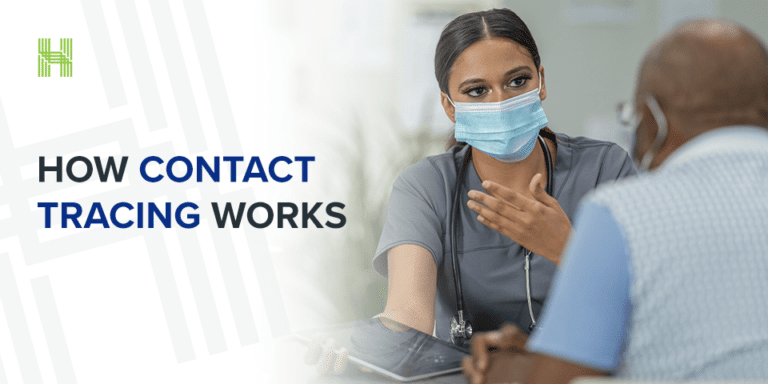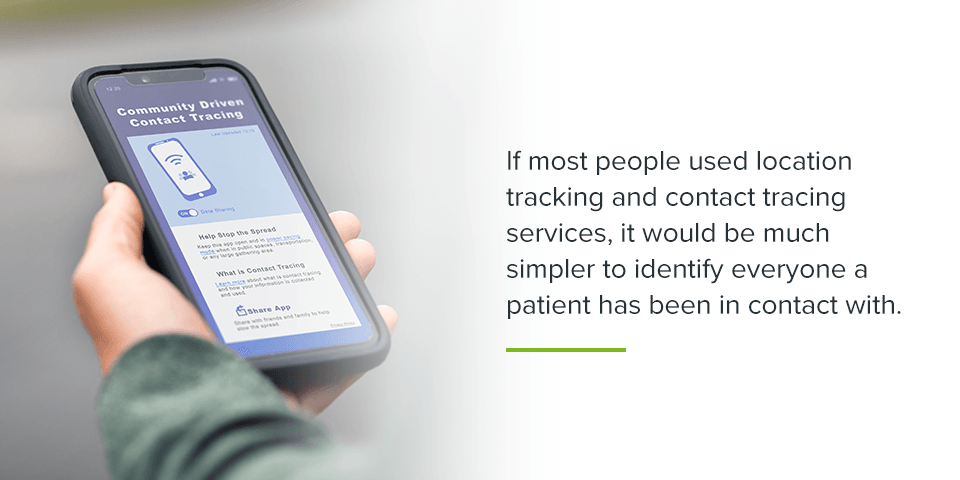Celebrating 20 Years in Business

In the earliest days of the COVID-19 pandemic, governments and health organizations scrambled for ways to protect vulnerable people and slow the spread of the virus. One vital strategy has been contact tracing, which involves warning those who have been in contact with the virus. Once someone learns of their exposure to the virus, they can quarantine to limit further spread.
Contact tracing is an effective strategy for limiting viral spread. Whether on the community, state or federal level, contact tracing keeps people informed and helps better organize quarantine efforts. Learn how contact tracing works, who performs it and how you can find contact tracing services for your workplace.
Contact tracing is one way a community can slow the spread of infectious diseases, including COVID-19. In essence, it’s the practice of tracking positive test results and notifying others of close contact with the virus. A contact alert lets people know they need to quarantine. Contact tracing has helped reduce the spread of COVID-19. It was also beneficial during the SARS epidemic of 2004, and advancing technology could make the strategy more effective during future viral outbreaks.

Contact tracing is a straightforward procedure in theory, though it can be challenging on a massive scale. With a highly infectious virus such as COVID-19, identifying every exposed person is easier said than done. Even so, the process for contact tracing is as follows:
A crucial factor in this process is finding everyone the patient has come in contact with. As you can imagine, this can pose a challenge, especially in heavily populated areas. Even with group gatherings suspended, people must still shop for supplies and groceries or use public transportation. Emerging technology may make contact tracing easier, thanks to location tracking on cellphones. If most people used location tracking and contact tracing services, it would be much simpler to identify everyone a patient has been in contact with.
One of the most fundamental ways to stop the spread of a virus is awareness of exposure. One primary issue with many viruses, including COVID-19, is that many people have no idea they’re carrying the virus until they’ve already infected others. Symptoms may not appear until after the infectious period. Fast, effective contact tracing alerts those who may be carrying the virus so they can quarantine themselves right away. This strategy stops the virus in its tracks.
Many different organizations can perform contact tracing, including small and large health offices and other institutions. In addition to HCRS, it’s possible to outsource contact tracing to any of the following entities.
Public or government health agencies focus on providing the public with information and resources. Examples of public health agencies include the FDA and the National Institutes of Health. Such agencies tend to operate on a large scale and have gained overall public trust, so they’re perfect for performing contact tracing services on a national level.
State health departments are responsible for protecting and improving citizens’ health. All 50 U.S. states have a state-level health department devoted to this purpose. Government involvement at the state level is beneficial, as state health departments have access to broad-scale data collection and other infrastructure. These departments can help with contact tracing during the spread of an infectious disease.
Local health departments are also helpful for contact tracing. These departments are responsible for upholding health standards in individual establishments like hotels, restaurants and schools. They can help limit viral spread within each community through contact tracing and enforcing sanitation standards.
Nonprofits can boost contact tracing’s effectiveness by aiding in communication. For instance, the Association of State and Territorial Health Officials provided nationwide training for COVID-19 contact tracing in April 2020. ASTHO is a national nonprofit organization connected with public health agencies across the country. This training helped local health facilities better understand how to implement contact tracing in their communities.
Many private companies have also helped improve contact tracing during the COVID-19 pandemic. Companies involved with geolocation data, cybersecurity, app development and other technology have made contact tracing quicker and more effective. In addition, private firms have improved health data quality and programs.
Universities nationwide have gotten involved with contact tracing. Schools may provide on-campus health services, including COVID-19 tests or tests for other infectious diseases. They can then alert students of contact. Since many schools function as miniature communities, this can successfully limit viral spread on college campuses.
Regardless of who performs contact tracing, these services can help stop the spread of infectious diseases. Alerting people of possible or confirmed exposure helps them take action to separate themselves from others. The sooner and broader-spread these alerts, the more effective they are.
Contact tracing is one of the most effective ways to stop a virus from spreading. Viruses rely on their ability to jump from host to host — this is how they survive and thrive. Alerting individuals of exposure to a virus gives them a chance to isolate themselves before they can infect others. Wide-scale, fast and effective contact tracing can eradicate a virus.
Now that many workplaces are reopening, contact tracing services for employers are particularly crucial. If you’re looking for contact tracing for your workplace, consider Healthcare Resolution Services. We offer data quality and performance services for health organizations with a mission to improve overall outcomes. Reach out today to learn about our workplace contact tracing services.